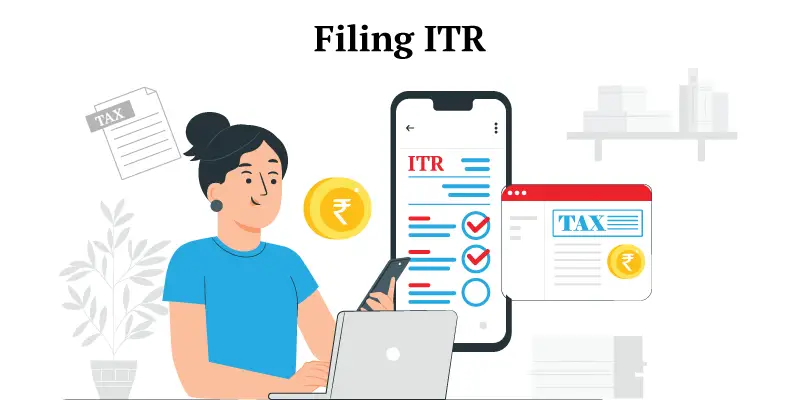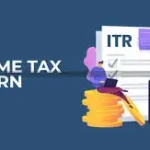
An individual must calculate their net taxable income, complete the appropriate ITR form, and pay any necessary taxes in order to file an income tax return. Make sure the ITR filed is checked once all taxes have been paid and it has been uploaded on the new income tax portal. Upon verification of the ITR, the tax agency will proceed with the processing. Once the ITR is processed, then intimation notice will be sent on your registered email id informing about whether your income tax calculations matches or with that of income tax department’s calculations. If it matches, then ITR filing process for a particular financial year is completed. If it does not match, then either you have income tax refund due or have income tax payment pending. If income tax refund is due to you, then it will be credited in your bank account, provided it is pre-validated on the new income tax portal. If the income tax payment is pending, then income tax department will ask you to make payment along with interest, if any.
How to calculate total taxable income for ITR filing?
To know the income tax an individual is required to pay, one must first calculate the total taxable income. The total taxable income is divided into five categories:
- Income from salaries
- Income from house property
- Income from capital gains
- Income from business/profession
- Income from other sources
INCOME FROM SALARIES:
This category encompasses earnings derived from salaries and pensions. If you receive a salary or pension from your employer, this income is subject to taxation under this head. For details regarding your salary or pension received during a specific financial year, you can refer to Form 16 (Tax Deducted at Source or TDS certificate) or your salary/pension slips. Various tax exemptions and deductions may be available on this income, such as House Rent Allowance (HRA) and Leave Travel Allowance (LTA). These exemptions apply if the payments are made by your employer. Additionally, salaried individuals and pensioners are entitled to a standard deduction on their salary or pension income.
INCOME FROM HOUSE PROPERTY:
Rental income earned from a house property falls under this category. To determine the taxable income from house property, one must consider the property’s occupancy status, which can be self-occupied, rented out, or deemed to be on rent. A property is considered self-occupied if the owner lives in it; if it is rented out, it is classified as on rent. If an individual owns more than two properties that are not rented out, the additional properties are treated as ‘deemed to be on rent.’ For properties that are rented or deemed to be on rent, taxpayers can claim a standard deduction of 30% of the rental income, along with deductions for municipal taxes paid and interest on home loans.
INCOME FROM CAPITAL GAINS:
Capital gains arise from the sale of assets such as land, houses, equity shares, mutual funds (both equity and debt), and gold jewelry. These gains can be categorized as either short-term or long-term based on the holding period of the asset. Different assets have specific holding periods to qualify as long-term. For example, equity shares and equity-oriented mutual funds must be held for more than one year, while real estate must be held for over two years to be considered long-term. Short-term and long-term capital gains are taxed at different rates depending on the asset class.
INCOME FROM BUSINESS/PROFESSION:
Individuals who earn income from business activities, freelancing, or consultancy should report this income under the category of ‘Income from Business/Profession.’ When filing their income tax return, business owners can claim various business-related expenses to reduce their taxable income and, consequently, their income tax liability.
INCOME FROM OTHER SOURCES:
This category includes all forms of income that do not fall under the previously mentioned categories. Examples include interest income from fixed deposits, RBI taxable bonds, family pensions, pensions from insurance policies, and dividends.
INCOME TAX REGIME OPTIONS:
Starting from the financial year 2020-21, individuals have the option to choose between the old income tax regime and a new, concessional tax regime. Under the old regime, individuals continue to pay tax according to the existing rates and can claim a wide range of exemptions and deductions. On the other hand, the new tax regime offers lower tax rates but requires individuals to forgo approximately 70 exemptions and deductions.
DOCUMENTS REQUIRED FOR FILING ITR:
The new income tax portal provides a pre-filled ITR form. However, it is crucial to verify this information as there may be errors. To ensure accuracy, gather the following documents: TDS certificates (such as Form 16 and Form 16A), interest certificates from savings accounts and fixed deposits, repayment certificates for loans (such as home or education loans), Form 26AS, Annual Information Statement (AIS), Aadhaar number, and bank account details.
CORRECTING MISTAKES IN ITR FILING:
If errors are found in your ITR, you have the option to correct them by filing a revised return. This can be done under Section 139(5) of the Income-tax Act, 1961, with the correct details. The deadline for submitting a revised return is December 31, unless an extension is granted by the government.
CHOOSING THE APPROPRIATE ITR FORM:
Selecting the correct ITR form depends on your sources of income. If you have income solely from salaries, one house property, and other sources, you can use ITR-1. However, if your income includes capital gains, you cannot use ITR-1 and must file using ITR-2 instead.
Related posts:
 Framework for Recognition of Self-Regulatory Organizations (SROs) in Financial Markets – Invitation of applications
Framework for Recognition of Self-Regulatory Organizations (SROs) in Financial Markets – Invitation of applications
 Union Finance Minister Smt. Nirmala Sitharaman chairs the review meeting of the Regional Rural Banks (RRBs) in New Delhi, today
Union Finance Minister Smt. Nirmala Sitharaman chairs the review meeting of the Regional Rural Banks (RRBs) in New Delhi, today
 US Fed must go big with 50 bps interest rate cut in September or risk recession
US Fed must go big with 50 bps interest rate cut in September or risk recession
 China’s spending slump is taking its toll on e-commerce giant Alibaba, which missed earnings estimates.
China’s spending slump is taking its toll on e-commerce giant Alibaba, which missed earnings estimates.
 Tax Exemption Limits for Allowances and Reimbursements Paid to Employees
Tax Exemption Limits for Allowances and Reimbursements Paid to Employees
 How to Claim Your Income Tax Refund Online for FY 2023-24
How to Claim Your Income Tax Refund Online for FY 2023-24